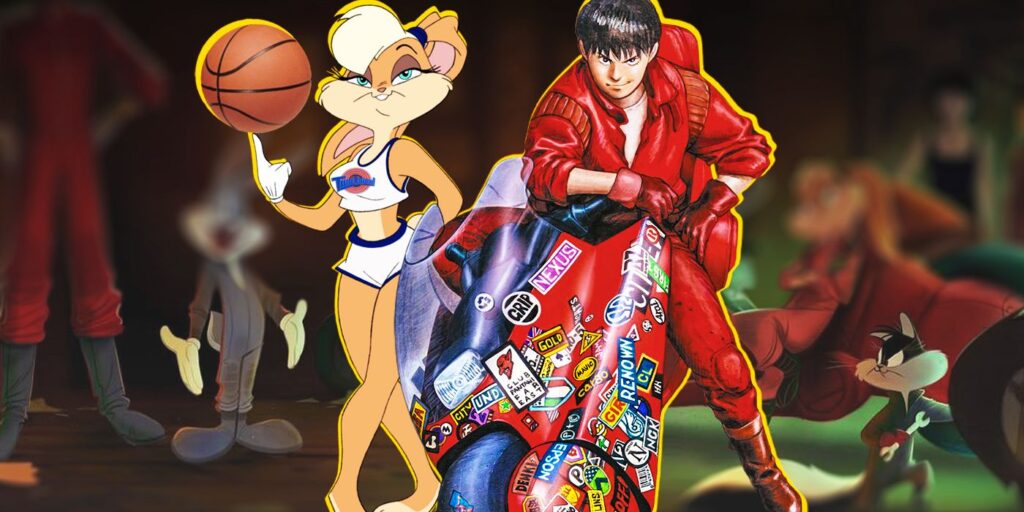The Collision of Two Cult Classics
In an era where pop culture boundaries blur and franchises often intermingle, the concept of a crossover between the Looney Tunes universe and the dystopian world of Akira might seem like a stretch. Yet, this very collision of genres—two quintessentially different yet equally influential cultural icons—has captured the imagination of fans and critics alike. This clash of aesthetics supposedly emerged in a lost scene from “Space Jam: A New Legacy”, a film already known for its eclectic mix of classic animation, sports drama, and a broad swath of Warner Bros. intellectual properties. The notion of such a crossover scene invites questions about artistic vision, genre hybridization, and the place of nostalgia in modern entertainment.
With “Space Jam: A New Legacy”, Warner Bros. didn’t just deliver a sequel to the beloved 1996 original but attempted to establish a broader meta-commentary on contemporary media landscapes. The movie, filled with cameos and references from various franchises, simultaneously celebrates and critiques the commodification of creativity. As details surrounding the deleted “Looney Tunes Meets Akira” scene surface, it becomes clear that the sequence wasn’t just a visual spectacle but a thematic keystone, embodying this tension between commercial nostalgia and genuine artistic fusion.
The Context: Revisiting the Madness of Akira and the Madness of Space Jam
Released in 1988, Akira is widely regarded as one of the most significant works of animation, exploring themes of power, identity, and dystopian futures with stunning visuals and a complex narrative. Set in a post-apocalyptic Tokyo, Akira delves into body horror, political unrest, and existential questions, making it an unlikely companion for the slapstick antics of the Looney Tunes.
On the other hand, Space Jam, in its various incarnations, has always been a celebration of zany humor and sportsmanship, layered with commercial undertones. The original 1996 film starring Michael Jordan capitalized on the popularity of basketball and the nostalgic appeal of the Looney Tunes, creating a cultural touchstone that was both loved and derided for its unabashed merchandising. Its 2021 sequel, “Space Jam: A New Legacy”, starring LeBron James, took these themes further by expanding into a kaleidoscopic world of cross-brand synergy.
The now-deleted sequence allegedly juxtaposed the comedic absurdity of the Looney Tunes with the high-stakes psychological drama of Akira, inserting Bugs Bunny and his cohorts into Neo-Tokyo’s chaos. It’s a concept both absurd and alluring, capturing the essence of Warner Bros.’ broader strategy of mixing and matching intellectual properties for maximum visual and emotional impact.
The Lost Scene: Bugs Bunny Goes Cyberpunk
Early animatics and storyboard leaks suggest that the sequence began with Bugs Bunny and Daffy Duck finding themselves in the heart of Neo-Tokyo. The cityscape—rendered in hyper-stylized CGI reminiscent of Akira’s gritty, neon-lit aesthetic—serves as an immediate contrast to the soft, rounded lines of the Looney Tunes. Bugs, in typical meta-commentary fashion, remarks, “Eh, what’s up, dystopia?” while Daffy, jittery and wide-eyed, mutters about wanting to be anywhere but here.
The scene’s narrative focus was on a chase sequence through the dystopian city, with Kaneda’s iconic red motorcycle weaving in and out of traffic, only to be interrupted by a misplaced Acme dynamite plunger operated by Wile E. Coyote. The comic relief here is palpable, but it’s executed against a backdrop of destruction and violence more akin to Akira’s intense tone. Reports suggest that the background animation was handled by Japanese studio Madhouse, lending it an authenticity that clashes deliberately with the cartoonish physics of the Looney Tunes.
Genre Blending and Thematic Disparity
The juxtaposition of Akira’s hyper-realistic body horror and cyberpunk aesthetic with the elastic, slapstick nature of Looney Tunes serves more than just a visual spectacle; it comments on the absurdity of trying to contain such disparate genres within a single narrative framework. The chase culminates in an unsettling sequence where Tetsuo’s powers spiral out of control, triggering his grotesque mutation. Yet, rather than a grotesque display of human anatomy, the mutation is reframed as an exaggerated, cartoony transformation—complete with Tetsuo’s limbs turning into oversized anvils and springs, accompanied by a chorus of the classic “Boing!” sound effect.
Bugs, attempting to defuse the situation, offers Tetsuo a carrot, claiming it’s a new experimental drug from the military, only to retract it with a cheeky grin: “Nah, just kidding, doc!” It’s a moment that highlights the incompatibility of these worlds. Bugs, who traditionally subverts reality through wit and irony, is powerless against the raw, uncontrolled power that Akira represents. The tonal dissonance reaches its peak when Tetsuo, caught between self-destruction and transformation, begins to resemble a monstrous parody of a Warner Bros. cartoon character—his face distorting into a grotesque smile reminiscent of the Tasmanian Devil.
Thematic Implications: Control, Power, and Identity
Thematically, the scene is rich with implications. Akira explores themes of unchecked power and the loss of identity under totalitarian regimes. By placing the Looney Tunes characters in this environment, the lost scene reflects on their own existence as symbols of control—both as characters manipulated by animators and as IP commodities in a vast corporate machine.
The sequence reportedly ended with Bugs, in a rare moment of vulnerability, staring at Tetsuo’s mangled form and whispering, “Sometimes, being in control isn’t all it’s cracked up to be.” It’s a line that resonates beyond the scene, hinting at Warner Bros.’ own awareness of the struggle between creative expression and the constraints of corporate interests. In “Space Jam: A New Legacy”, LeBron James’ character wrestles with the demands of being a father, an athlete, and a celebrity, all while being trapped in a digital realm that monetizes his likeness. The deleted scene with Akira amplifies these themes, suggesting that even beloved characters like Bugs are not immune to the forces that seek to control and commodify them.
Why Was It Cut?
Given its thematic depth and visual complexity, why was the scene cut from the final version of Space Jam: A New Legacy? Reports indicate that studio executives were concerned about the tonal inconsistency, fearing that Akira’s dark and unsettling themes would alienate the movie’s target demographic of families and casual viewers. Indeed, a dystopian, body-horror-inflected sequence might seem wildly out of place in a movie where Porky Pig raps and the stakes are resolved with a basketball game.
Yet, in cutting the scene, the film loses an opportunity to transcend its status as a mere sequel and commentary on cross-media franchising. The Akira crossover, if included, could have served as a bold statement on the nature of creativity, identity, and the cost of power—paralleling the struggles of LeBron’s character with that of Tetsuo, both of whom grapple with expectations and the fear of losing control.
A Missed Opportunity for Transcendence
The “Looney Tunes Meets Akira” scene remains one of the most tantalizing ‘what-ifs’ in recent cinema history. Its exclusion speaks volumes about the risk-averse nature of blockbuster filmmaking, especially when it comes to IP-driven projects. The scene would have been a jarring, thought-provoking moment in an otherwise straightforward narrative, challenging audiences to confront the inherent contradictions in the Looney Tunes’ slapstick comedy when set against the dark existentialism of Akira.
While “Space Jam: A New Legacy” embraced a multitude of crossover moments, from Batman to “The Matrix”, none of them dared to probe as deeply as this lost scene might have. Most references functioned as mere Easter eggs, nods to the past rather than engagements with it. The Akira crossover, on the other hand, had the potential to redefine what such crossovers could be—not just celebratory fan service, but meaningful commentary on the worlds these characters inhabit and the themes they explore.
The Legacy of a Scene That Never Was
The lost “Looney Tunes Meets Akira” scene from “Space Jam: A New Legacy” represents more than just a quirky piece of trivia; it is a glimpse into a version of the film that dared to break free from formulaic storytelling. By embracing the chaos of genre-blending and allowing its characters to confront their own commodification, the scene could have elevated “Space Jam: A New Legacy” into a unique critique of the entertainment industry’s reliance on nostalgia and intellectual property.
In the end, its absence from the final cut is a reminder of the limits placed on creativity in mainstream cinema. What remains is the tantalizing potential of what could have been: a world where Bugs Bunny stands not just as a trickster figure, but as a witness to the dangers of unchecked power, staring down the abyss of a dystopian future that he can neither outwit nor escape.
No comments yet.







